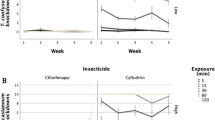Abstract
Accumulated grain dust and flour residues in flour mills can potentially decrease the efficacy of contact surface treatments and aerosol insecticides used for control of adult and immature stages of stored product insects. A study was conducted to evaluate the effects of flour residues on the efficacy of piperonyl butoxide-synergized pyrethrin aerosol against different life stages of the confused flour beetle, Tribolium confusum Jacquelin du Val. Twenty individual adults, pupae, or larvae of T. confusum, confined in Petri dishes containing 0, 0.1, 1, 5, or 10 g of wheat flour, were exposed separately inside an empty shed to the label rate of the aerosol. The formulation contained 1 % active ingredient pyrethrin and the label application rate was 1.04 ml/m3. After 2 h of exposure, all dishes were removed from the shed and placed in an incubator set at 27 °C and 60 % RH. Mortality of T. confusum adults decreased with increasing amount of flour. Recovery of moribund adults 15 days after exposure was greater in the 5 and 10 g flour dishes (15 and 46 %) compared to the 0.1 or 1 g flour dishes (0.7 and 5 %). As the flour amounts increased, more larvae and pupae were able to emerge as adults. Results show accumulated flour residues during aerosol application can compromise aerosol efficacy, and also suggest the flour impaired penetration ability of the aerosol. These results also emphasize the importance of sanitation and cleaning to remove spillage and extraneous material prior to an aerosol application.



Similar content being viewed by others
References
Arthur FH (2000) Impact of accumulated food on survival of Tribolium castaneum on concrete treated with cyfluthrin wettable powder. J Stored Prod Res 36:15–23
Arthur FH (2010) Residual efficacy of aerosols to control Tribolium castaneum and Tribolium confusum. In M.O. Carvalho et al. (Eds.), Proceedings of the 10th International Working Conference on Stored Product Protection, 27 June to 2 July 2010, Estoril, Portugal. Julius Kühn-Institut, Berlin, Germany, pp 789–792
Arthur FH, Campbell JF (2008) Distribution and efficacy of pyrethrin aerosol to control Tribolium confusum (Coleoptera: Tenebrionidae) in food storage facilities. J Stored Prod Res 44:58–64
Beckett SJ, Fields PG, Subramanyam B (2007) Disinfestations of stored products and associated structures using heat. Heat treatments for postharvest pest control: theory and practice. CAB International, Oxon, pp 182–236
Bernhard KM, Bennett GW (1981) Ultra-low-volume applications of synergized pyrethrins for stored-product insect control. J Econ Entomol 74:572–576
Brijwani M, Subramanyam B, Flinn PW (2012) Impact of varying levels of sanitation on mortality of Tribolium castaneum eggs and adults during heat treatment of a pilot flour mill. J Econ Entomol 105:703–708
Campbell JF, Arbogast RT (2004) Stored product insects in a flour mill: population dynamics and response to fumigation treatments. Entomol Exp Appl 112:217–225
Campbell JF, Runnion C (2003) Patch exploitation by female red flour beetles, Tribolium castaneum. J Insect Sci 3:20
Casida JE (1980) Pyrethrum flowers and pyrethroid insecticides. Environ Health Perspect 34:189–202
Cox C (2002) Insecticide synergist fact sheet: piperonyl butoxide. http://www.pesticide.org/get-the-facts/pesticide-factsheets/factsheets/piperonylbutoxide. Accessed 23 Jan 2013
Keane P (1998) The use of piperonyl butoxide in formulations for the control of pests of humans, domestic pets and food animals. In: Jones DG (ed) Piperonyl butoxide: the insecticide synergist. Academic Press, London, pp 289–300
McDonald LL (1968) Relative effectiveness of tropital and piperonyl butoxide as synergists for pyrethrins against stored product insects. J Econ Entomol 61:1645–1646
Robertson JL, Savin NE, Preisler HK, Russell RM (2007) Bioassays with arthropods, 2nd edn. CRC Press, Boca Raton
Sokoloff A (1974) The biology of Tribolium: with special emphasis on genetic aspects, vol 2. Clarendon Press, Oxford
Stanley MSM, Grundmann AW (1965) Observations on the morphology and sexual behavior of Tribolium confusum Duval. J Kans Entomol Soc 38:10–18
Sutton AE, Arthur FH, Zhu KY, Campbell JF, Murray LW (2011) Residual efficacy of synergized pyrethrin and methoprene aerosol against larvae of Tribolium castaneum and Tribolium confusum (Coleoptera: Tenebrionidae). J Stored Prod Res 47:399–406
Toews MD, Campbell JF, Arthur FH (2010) The presence of flour affects the efficacy of aerosolized insecticides used to treat the red flour beetle, Tribolium castaneum. J Insect Sci 10:1–14
Trematerra P, Sciarretta A (2004) Spatial distribution of some beetles infesting a feed mill with spatio-temporal dynamics of Oryzaephilus surinamensis, Tribolium castaneum and Tribolium confusum. J Stored Prod Res 40:363–377
Trematerra P, Gentile P, Brunetti A, Collins LE, Chambers J (2007) Spatio temporal analysis of trap catches of Tribolium confusum du Val in a semolina mill with a comparison of female and male distributions. J Stored Prod Res 43:315–322
Wijayaratne LK, Fields PG, Arthur FH (2012) Residual efficacy of methoprene for control of Tribolium castaneum (Coleoptera: Tenebrionidae) larvae at different temperatures on varnished wood, concrete, and wheat. J Econ Entomol 105:718–725
Zar JH (2010) Biostatistical analysis, 5th edn. Pearson Prentice-Hall, Upper Saddle River
Acknowledgments
We thank Brian Barnett, Rich Hammel, and Kris Hartzer for their technical assistance with the research and Entech Corporation for providing the insecticide used in this study. This research was partially funded by the U. S. Department of Agriculture, National Institute of Food and Agriculture (NIFA), Methyl Bromide Transitions program (grant number 2010-51102-21660). Insect voucher specimens were deposited at the Kansas State University Museum of Entomological and Prairie Arthropod Research under voucher number 226. This paper is contribution number 14-058-J of the Kansas Agricultural Experiment Station, Kansas State University, Manhattan, KS. Mention of trade names or commercial products in this publication is solely for the purpose of providing specific information and does not imply recommendation or endorsement by the U.S. Department of Agriculture or by Kansas State University. USDA and Kansas State University are equal opportunity providers and employers.
Author information
Authors and Affiliations
Corresponding author
Additional information
Communicated by C. G. Athanassiou.
Rights and permissions
About this article
Cite this article
Kharel, K., Arthur, F.H., Zhu, K.Y. et al. Susceptibility of different life stages of Tribolium confusum to pyrethrin aerosol: effects of a flour food source on insecticidal efficacy. J Pest Sci 87, 295–300 (2014). https://doi.org/10.1007/s10340-013-0549-z
Received:
Accepted:
Published:
Issue Date:
DOI: https://doi.org/10.1007/s10340-013-0549-z



